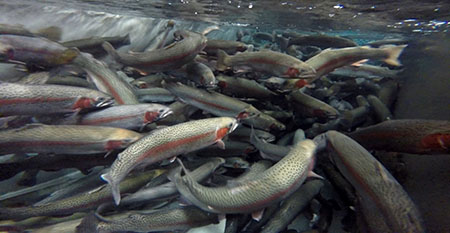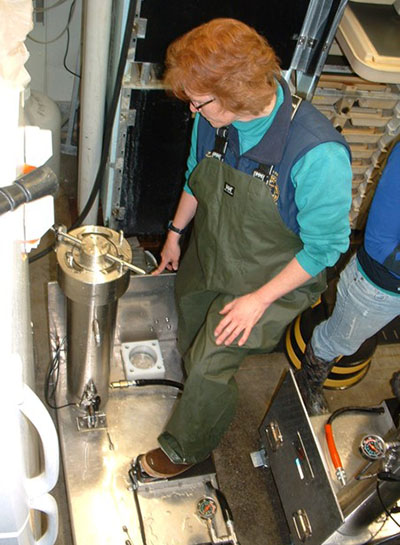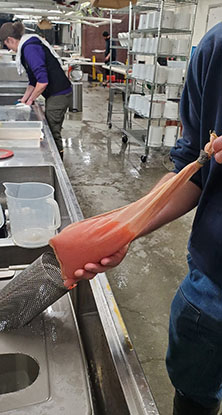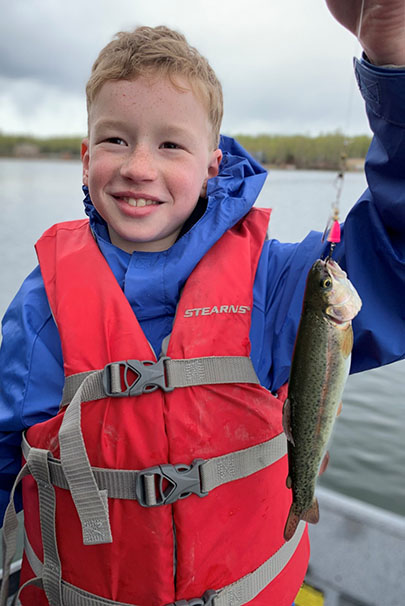Alaska Fish & Wildlife News
September 2024
Stocking Rainbow Trout
Triploid Fish for Conservation

You peer into crystal-clear water and see hundreds of brightly colored rainbow trout ready to spawn. Most people never see rainbow trout during the spawning season, but this isn’t the Kenai River. It is December in the brood holding tanks at the William Jack Hernandez Sport Fish Hatchery in Anchorage. Both light and temperature are controlled here by fish culturists to trick rainbow trout into thinking it’s time to spawn, months earlier than they would in the wild.
Roughly 4,500 adult rainbow trout are held each year to support the Division of Sport Fish’s extensive rainbow trout enhancement program. Just over 3 million eggs are collected each year and help provide fishing opportunities throughout Interior, Southeast, and Southcentral Alaska including Kodiak Island. These fisheries allow sustainable rainbow trout harvest from ponds in Ketchikan to remote lakes on the Kenai Peninsula and redirect fishing pressure away from wild populations of trout.

While these trout themselves are a conservation tool, another conservation tool is being employed: triploidization. “What is that?” you might ask, “And why is this done?” would be an appropriate follow-up question. Triploidization is a process that, very generalized, takes a normal egg with two sets of chromosomes (diploid) and gives it a third set of chromosomes (triploid). These triploid fish become sterile and are unable to reproduce. Fish that cannot reproduce have a much smaller impact on natural systems and will eventually disappear if stocking is ended. In 2024, about 94% of the rainbow trout stocked were triploid and all female (more on all female in a future article).
Rainbow trout are not the only triploid species stocked by Fish and Game. The vast majority of lake stockings are triploid fish and include Arctic char, Chinook salmon, coho salmon, lake trout, and Arctic grayling. Interestingly, each species has a slightly different ‘recipe’ to follow to induce triploidy. These recipes were pioneered by retired fish biologist Diane Loopstra for ADF&G and include precise timing, teamwork, and about 10,000 psi.

As stated earlier, the exact details vary among species, but all follow a similar process. Eggs are collected from an adult trout or salmon and may be combined with other eggs until 10,000 or so eggs are present. Now these eggs won’t do much on their own. They still need water and sperm, commonly called milt, to form a living, growing egg. To induce triploidy, a very specific stage in cell development is targeted. This requires careful coordination between the person activating the eggs and milt (with water) and the person operating the pressure chambers. Roughly 45 minutes after activation our 10,000 eggs are exposed to pressures right around 10,000 psi. This pressure disrupts cell division, leaving an extra set of chromosomes in the egg that would normally be removed. From this point on, the cells divide and develop normally with three sets of chromosomes rather than two, making the fish triploid.

There are strict genetic policies in place that guide stocking in Alaska. In addition to following the ‘recipe’ for triploid fish, fish culturists must confirm that fish are triploid through testing and certification. All groups of triploids must test at least 90% triploid, with the majority requiring 99% triploid before they can be certified and stocked. Testing is conducted by staining the DNA in a collected sample with reflective dye and then measuring the amount of reflected light. The more reflection, the more DNA present. Triploid cells have 50% more DNA than a diploid cell. When a sample is compared to a known diploid, it can easily be identified as triploid or not.
It is important to recognize that these fish are not genetically modified. Genetically modified organisms have had their genetic code altered through genetic engineering. With triploidization, cell division is interrupted at a specific time and a third chromosome is retained, no alterations made. Triploid fish pose no health risk when eaten.

A core function of the Division of Sport Fish is to create and diversify sport fishing opportunities across the state. Achieving this function sustainably and minimizing environmental impacts are high priority. Using genetic standards to guide our hatchery enhancement through tools like triploid fish stocking allows Fish and Game to successfully accomplish these goals. Those brightly colored rainbow trout might not be living in the Kenai, but they are serving a very important purpose. They help provide remote fishing experiences, local first catches, and evening dinners to thousands of Alaskans every year.
David Starzynski is a fish biologist working for the Sport Fish enhancement program where he oversees triploid induction, certification, and planning.
Subscribe to be notified about new issues
Receive a monthly notice about new issues and articles.
